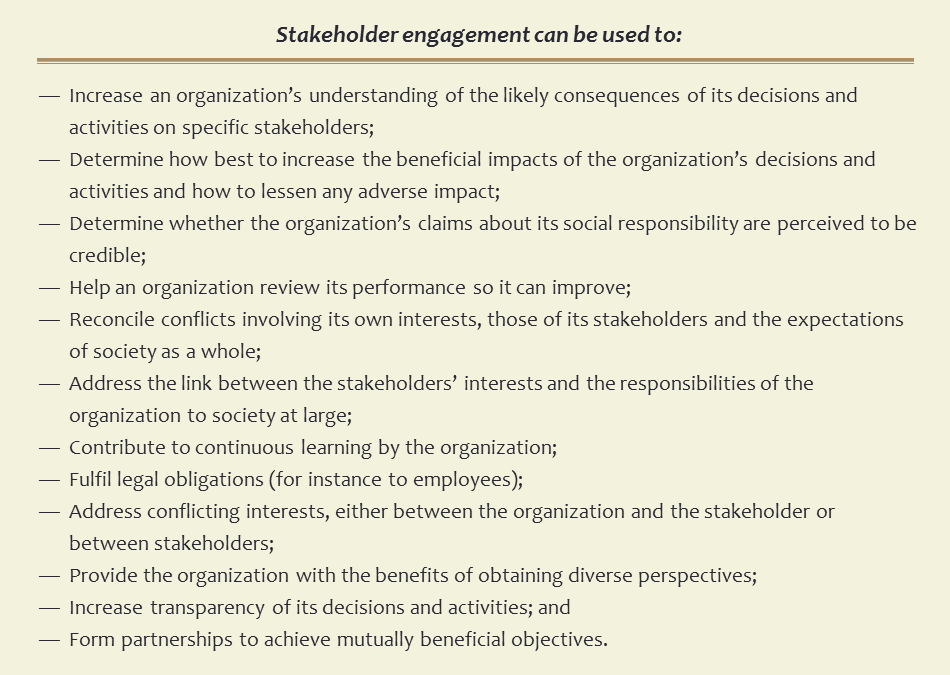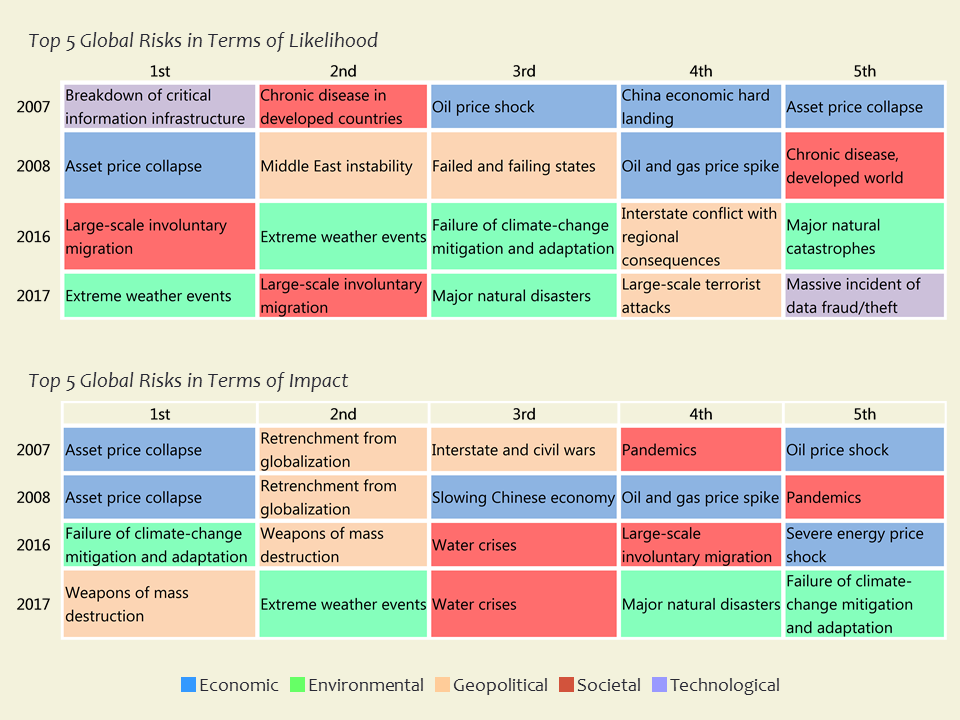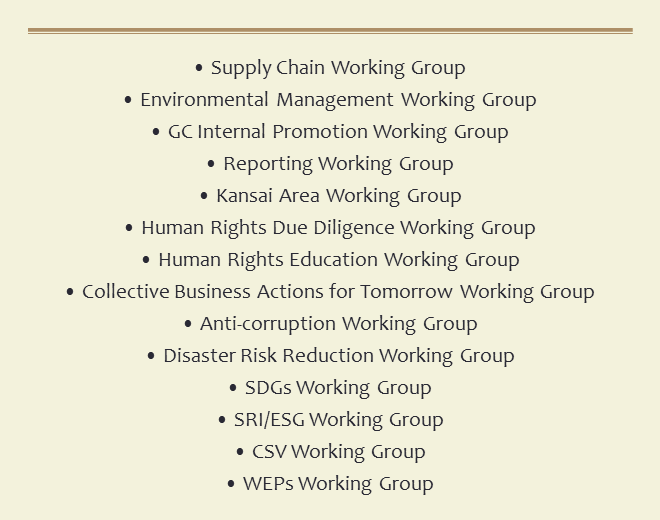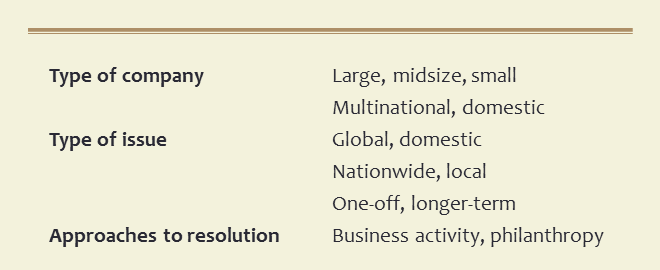- Article
- Industry, Business, Technology
An Assessment of Collaboration between the Business and Social Sectors
July 11, 2018

The Japanese word commonly used to refer to the growing areas of collaboration between the corporate and social sectorsー kyodo ーcan have different meanings for different people, as suggested by the variety of English termsー“dialogue,” “communication,” and “engagement”ーinto which it has been translated. Here, I will use the word for the activities described in ISO 26000 under “5.3.3 Stakeholder Engagement” (Table 1), particularly the last item: “form partnerships to achieve mutually beneficial objectives.” [1] This, perhaps, is the most widely recognized usage of the term.
Dialogue, needless to say, is an essential component of collaboration between the business and social sectors. But as noted in this and earlier CSR white papers, [2] companies appear to be engaging less actively in dialogue with the social sector than with other stakeholders. I have been a longtime reader of corporate CSR reports andーwith their recent proliferationーintegrated reports, and I am often asked to offer my assessment of them. For this task, I generally seek a briefing of each company’s CSR initiatives, at times interviewing and exchanging opinions with employees and relevant officers. In the following, I will draw on such experience and the findings of other researchers to give an overview of the issues faced, respectively, by private companies and the social sector, as well as the challenges the two sectors have in common. I also hope to outline future directions for business-social collaboration.
Table 1. “5.3.3 Stakeholder Engagement,” ISO 26000: 2010 (Excerpt)

Source: ISO 26000: 2010(E), Guidance on Social Responsibility .
Issues for Private Businesses
First, let us look at the issues confronting private businesses. Stakeholder dialogue in itself does not appear to be a weakness, as the survey conducted in 2016 by the Tokyo Foundation for Policy Research’s CSR research project found that around 90% of responding companies were engaged in dialogue of some kind with their stakeholders . The 2014 survey, too, found that 82% conducted dialogue, of which 60% to 80% maintained channels of communication with external stakeholders . The problem, as pointed out in the 2015 white paper, was that the choice of dialogue partners was not guided by an interest in addressing social issues; companies would show greater concern, the white paper surmised, had companies maintained regular contact with civil society organizations or socially vulnerable groups. I suspect, though, that there are other dimensions to consider.
The first is the confusion regarding the reasons for dialogue. Companies conduct various forms of dialogue with many different stakeholders from the time they are founded. It has only been since the early 1990s, though, as Japanese companies began publishing environmental reports, that they have begun to communicate such activities publicly.
Businesses started issuing CSR reports after the first Sustainability Reporting Guidelines (G1) were issued in 2000 by the Global Reporting Initiative. The resulting profusion of CSR reports in Japan has led to 2002 being dubbed “year one of CSR reporting.”
One purpose of dialogue with stakeholders, as described in the 2015 white paper , is to keep abreast of society’s ever-changing expectations, as well as to tap the expertise those stakeholders possess. In reality, though, many dialogues seem to be held primarily for the purpose of generating content for companies’ annual CSR reports. How such dialogue leads to real change in corporate behavior is difficult to gauge. I know from personal experience that it can produce change, but there is still a long way to go before stakeholder dialogue begins to truly inform longer-term management policy.
The second area requiring greater scrutiny is the bias in the type of social issues companies take up. Businesses often make the mistake of regarding internal issues as social ones, as was noted in the 2015 white paper , and this has led to ambiguity in the selection of material issues.
Dialogues with stakeholders are often held on the topic of materiality, partly because many reporting guidelines demand transparency in the selection of material issues. The criteria for choosing such issues are clear. According to the GRI Sustainability Reporting Standards , “Material topics are those that reflect an organization’s significant economic, environmental and social impacts; or that substantively influence the assessments and decisions of stakeholders” (Disclosure 103-1, “Explanation of the Material Topic and Its Boundary,” GRI 103: Management Approach 2016 ).
This is essentially the definition that the GRI has been using since it published the G3 Sustainability Reporting Guidelines in 2006. The problem is that, in practice, the meaning of “the organization’s significant economic, environmental and social impacts” had been misinterpreted by some companies as referring only to impacts with significant consequences for the organization itself, while “substantively influence the assessments and decisions of stakeholders” had been seen as dealing with impacts for stakeholders.
Materiality, in other words, came to be seen as any issue affecting a company, such as financial costs or a change to its reputation, resulting in the weakening of the intended linking of social issues with the contributions companies were making (positive or negative) to sustainable development. As a consequence, a clarification was required when publishing the GRI Standards to ensure that in determining material issues, an organization considers the full picture of its significant outward impacts on the economy, the environment, and societyーnot only those that have immediate consequences from a business perspective.
The third area private businesses need to consider is the choice of dialogue partners. Given the first two issues, companies have tended to choose from a rather narrow field, namely, organizations with whom they have business ties, relevant government agencies, and experts in the internal issues facing the company. Few have taken the trouble to reach out to the NPOs and NGOs that are actively engaged in addressing society’s issues.
The fourth issue is a preoccupation with generating short-term results in the light of the quarterly settlement cycle. The management targets of most companies usually cover a period of just three to five years, at longest, and meeting them often becomes an end in itself. As a result, businesses have little time to consider longer-term goals and missions or to address social issues. An Environment Ministry survey on eco-friendly corporate behavior, published in March 2017, showed, for example, that even for something as conventional as curbing greenhouse gas emissions, few responding companies had a target spanning longer than five years; the percentage of businesses with targets covering 10 year or longer was just 12.5%
There has been some progress, though, since the adoption of Japan’s Stewardship Code in 2014 and the Corporate Governance Code in 2015, as well as the entry into force of the Paris Agreement in 2016, and I have high hopes that more businesses will embrace longer-term strategies and goals, as companies without such a vision will face mounting risks of being driven out of the market.
The fifth issue for private businesses is their failure to take note of rapid changes in society’s needs. Meiji Japan’s biggest priorities were to “enrich the state and strengthen the military,” as expressed in the political slogan fukoku kyohei , and private enterprises assiduously devoted themselves to industrial development. Following World War II, the country focused on economic reconstruction under such concepts as shotoku baizo (doubling of income) and ichi oku sochuryu (a middle-class society of 100 million). They succeeded in elevating the country into one of the world’s biggest economies, but Japan has been unable to adjust to more recent developments. The advance of globalization in the 1980s has led to a worldwide decline of the middle class, and Japan, too, has been in the throes of “two (three?) lost decades” of economic stagnation since the early 1990s. Gone are the days when Japan could proudly declare itself to be an egalitarian society, as it now ignominiously ranks second among the developed economies in income inequality.
The Global Risks Report , published annually by the World Economic Forum, provides an overview of the evolving risks landscape. [3] According to the 2017 study, the main risks between 2007 and 2017 have shifted from the economic realm to the environmental field (Table 2). [4]
Comparing the five biggest perceived risks in terms of likelihood and impact in 2007-08 and 2016-17 shows a clear shift from economic to environmental issues. In 2007-08, economic issues were cited 10 times, geopolitical issues 5 times, social issues 4 times, and technological issues once. A decade later, environmental issues topped the list, being cited 9 times, with social issues being cited 5 times, geopolitical issues 4 times, and technological and economic issues once each. It should be noted that “water crises,” which was the third biggest perceived risk in terms of impact in 2016-17, is classified here as a social issue, rather than an environmental one.
Table 2. The Evolving Risks Landscape, 2007-2017

Source: World Economic Forum, The Global Risks Report 2017, 12th Edition, 2017.
Issues for the Social Sector
Next, I would like to turn to the challenges faced by the social sector. In the West, many different organizations advance a variety of agendas on the strength of scientific evidence, legal requirements, or public opinion. Some take a decidedly hostile attitude toward private business, while others actively seek out corporate partners. Their activities tend to have a particular focus, such as protecting the environment, upholding human rights, or preventing corruption. In addition to international NGOs, there are many active local groups, not just in the industrial countries but also in developing and emerging economies.
The social sector in Japan consists of such disparate groups as nonprofit organizations, associations, and foundations. The vast majority, though, are NPOs, of which 51,608 were registered as of May 2017. [5] This is by no means a small number, but few have ventured to engage in the kind of dynamic collaboration with the private sector that can make a real difference in the resolution of social issues.
The reasons for this are varied. One is the absence of institutional support for the formation and growth of the social sector dating back to the Meiji period. For 112 years, public-interest organizations were regulated by Japan’s Civil Code, enacted in 1896, until the provisions for nonprofit groups were amended in 2008 as the Act on General Incorporated Associations and General Incorporated Foundations. Article 33 of the older law stated that associations or foundations could be formed as juridical persons if “it is formed pursuant to the applicable provisions of this Code or other laws,” thus adhering to the principle of authorizing the establishment of juridical persons when the stated requirements are satisfied. But Article 34 stipulates, “Any association or foundation . . . which is not for profit” requires “the permission of the competent government agency” to “be established as a juridical person. [6] Nowhere does the law describe the criteria that must be met before the “competent government agency” will give its permission. This compelled many social-sector organizations to operate for years without the status of a juridical person.
The January 1995 Kobe earthquake prompted a rethinking of the role of nonprofits, and in 1998, the Law to Promote Specified Nonprofit Activities (NPO Law) was enacted. The law required those wishing to establish an NPO to submit an application to the government agency with jurisdiction for specified nonprofit corporations and obtain an “authentication of establishment.” It was not until 2008, when the legal framework covering the nonprofit sector was amended, though, that associations and foundations could be established without the approval of a competent authority, as long as the application satisfied all legal requirements.
A second issue for the social sector is the shortage of both personnel and funds.[7] The median number of employees at nonprofits in Japan is seven, and the median figure for paid, full-time employees is just two. The average number of members is 22 (the median is 17), and average annual income is a mere 4.8 million yen (the median is 2.1 million yen).
The donation tax system was revised in 2011, easing the criteria for becoming a nintei (certified) NPO and conferring higher tax benefits to such NPOs. Since then, the number of nintei NPOs has gradually been rising, although there are still only 1,018 such organizations as of May 2017ーa mere 2% of all NPOs. [8]
The third issue is that many nonprofits lack of business experience, especially at the management level. Many people in the social sector are highly dedicated to their work, enduring long hours and low pay, but fewーit seems to meーhave the skills and experience needed to enter into a collaborative partnership with private businesses. This contrasts with the “revolving door” in many Western countries, where there is considerable mobility between the business and social sectors.
Issues Common to Both Sectors
There are also a number of issues that both sectors need to address. One is the tendency to focus on a very narrow range of topics, whichーin the case of businessesーmay be an outgrowth of a tendency to undertake initiatives before ample deliberations have taken place on what issues each organization is best positioned to address. [9]
Some progress is being made in this area, however. Global Compact Network Japan, of which I serve as a director, has established working groups on various social issues (Table 3), where participating businesses can learn from the best practices of other companies and deepen their understanding of CSR through deliberation and exchanges of information. [10] The working groups also present opportunities for exchange with the social sector, providing a forum for the two sectors to learn about each other.
Table 3. The Working Groups of Global Compact Network Japan, 2016

Source: Global Compact Network Japan website, http://ungcjn.org/activities/session/2016.html .
Social sector organizations, meanwhile, have good reasons for narrowing the focus of their activities. The NPO Law stipulates that in order to gain the status of a nonprofit corporation, their activities must fall within one of the 20 specific areas set forth in the law and that they must also benefit society by “contributing to enhancing the interests of many and unspecified persons.” In other words, they must identify their purpose as being one of the 20 activities listed, ranging from (1) activities for enhancing healthcare, medical care, and welfare to (20) activities specified by an ordinance of the prefecture or designated city as those equivalent to the activities set forth in the preceding items. To operate as an NPO, a group needs to not only work for the benefit of society but also adhere to one of 20 legally prescribed activities. Many operate on a very small scale, as I have mentioned, and have their hands full just addressing their most central concerns.
The second issue businesses and nonprofits share is an unconscious assumption that coping with issues affecting society at large is the domain of the government sector. The explanatory notes to Book 1 (Persons) of the Old Civil Code of Japan (1890) stated that lawmaking officials shall be solely responsible for measures pertaining to the welfare of society. The underlying premise is that the state shall have a monopoly on matters of public welfare, and this notion appears to have since become the prevalent view in society.
This may be what prompts so many corporate managers and employees to proclaim, without giving the idea much thought, that private businesses have no responsibility toward poverty eradication. There is a general tendency in Japan not to face social issues directly or openly.
Prior to the enactment of the NPO Law, there was a tendency to view people in civil society as being somewhat “different” from those in the mainstream, and this impulse persists to some degree today. This inclination, too, may be an outgrowth of the bias that dealing with social issues is the job of the public sector.
There has been an emphasis in recent years on new approaches to public management, such as by utilizing private-sector dynamism, in the face of mounting fiscal constraints. But this has not resulted in a fundamental shift in the viewーprevailing since the start of Japan’s modernizationーthat the government sector is primarily responsible for public welfare. This may also explain the underdeveloped state of Japan’s donation culture. Unless both the public and private sectors move beyond this mindset and work together toward the achievement of the SDGs, little progress will be made in resolving social issues through private-public collaboration.
The third issue that the business and social sectors share is that CSR is still mistakenly equated with corporate philanthropy. While there is a growing perception that CSR means undertaking all business operations in a socially responsible manner and is at the heart of business management, such an awareness is usually to be found only among a narrow circle of senior managers and CSR/environment officers. Some of the more progressive companies, such as Shiseido, Mitsui & Co., and Suntory, now use “sustainability” for the names of the divisions and committees overseeing socially responsible initiatives, perhaps to facilitate the integration of CSR and environmental considerations into their main business operations.
The social sector, too, continues to view CSR in a narrow sense, urging businesses to become more engaged in CSR when what the nonprofits are really seeking, in fact, are donations. Such misperceptions must be cleared first before the two sectors can truly begin working collaboratively to resolve society’s biggest challenges.
The Future of Collaboration
Finally, I will examine concrete approaches to encouraging cross-sector collaboration. Table 4 outlines the factors to be considered in this endeavor; first let us look at ways to resolve “longer-term issues” through a company’s “main business activities.” [11]
Benefits to both sides must be sustained if business strategies are to be employed in resolving social issues. Initiatives, even for the best of causes, will come to a halt unless they continue to generate profits for companies and lead to funding for nonprofits. This, though, does not preclude the use of philanthropic “strategic donations” to get initiatives off the ground.
One challenge confronting Japanese society from a longer-term perspective is poverty and income inequality, especially as faced by single-parent households. This is an issue that can be addressed by companies of all sizes. If it involves efforts to revitalize outlying regions, it may require collaborating closely with the public sector as well. Such a tripartite arrangement would encourage parties to treat each other as equal partners, helping to mitigate the unconscious tendency, described above, to defer to the views of government officials.
What would such collaboration actually look like? One example would be for a company to establish a policy of actively hiring single mothers, which would help it to build a sustainable supply chain. An NPO working toward poverty reduction and regional revitalization could help match job openings to applicants and ensure that workers’ rights are being protected. The local government can adopt measures to facilitate such initiatives and promote economic activity. Ending poverty is the first of the 17 SDGs, and alleviating the poverty of single-parent households would contribute to achieving Goal 5 of gender equality and empowerment of all women and girls. The initiative can also help meet Goal 8 of decent work and economic growth.
Table 4. Factors in Promoting Business-Social Collaboration

Source: Created by the author.
Companies can also apply business strategies to address longer-term, global-scale issues by partnering with either local NPOs or international NGOs. They can work with multilateral institutions like UNICEF and the UN Development Program, as well as with programs like the International Labor Organization’s Better Work. Additionally, forging collaborative ties with local governments would bolster the chances of long-term success.

Examples of such success include the “One Chocolate for One Smile” project undertaken by Morinaga & Co., a maker of confectionaries. In fact, any company that launches operations in a developing country in search of sustainable suppliers and markets must contribute to poverty eradication, decent work, and other social issues if it hopes to remain a viable presence in that country. Another interesting example of a successful transnational initiative is Borderless Japan, a group of young social entrepreneurs who are addressing social issues in developing countries using a social business approach.
The ball is largely in the business sector’s court; companies must be the ones to get it rolling toward fruitful collaboration. This will first require that senior and middle managers discard their notions that the government is responsible for dealing with social issues. The model private enterprise of the twenty-first century is one that proactively takes on the challenge of mitigating the problems confronting society and offers incentives to encourage employees to do so as well. This would enhance the social capital of both the company and its workers and will contribute to raising the company’s brand value.
[1] Translator’s note: Kyodo is translated here and elsewhere in the 2017 CSR white paper as “collaboration.”
[2] The Tokyo Foundation for Policy Research has issued four CSR white papers to date, starting in 2014.
[3] Based on a survey of forum participants, who were asked to select the most important risks in the next 10 years in five categories: economic, environmental, geopolitical, societal, and technological.
[4] World Economic Forum, The Global Risks Report 2017 , 12th Edition, 2017.
[5] Cabinet Office, NPO Homepage (Japanese only, last accessed July 13, 2017), https://www.npo-homepage.go.jp/about/toukei-info/ninshou-seni .
[6] http://www.japaneselawtranslation.go.jp/law/detail/?id=2057&vm=&re =.
[7] Cabinet Office, NPO Homepage, Surveys on Specified NPOs and Voluntary Activities by Citizens (Japanese only), https://www.npo-homepage.go.jp/toukei/npojittai-chousa/2015npojittai-chousa ; https://www.npo-homepage.go.jp/toukei/shiminkouken-chousa/2015shiminkouken-chousa .
[8] Op. cit. , note 5.
[9] This has been pointed out in many articles of previous CSR white papers. See http://www.tokyofoundation.org/en/topics/csr .
[10] Global Compact Network Japan promotes the worldwide corporate sustainability initiative in Japan. The network had 246 corporate members as of July 20, 2017.
[11] Addressing single-instance issues is, of course, important as well. One successful example of such cross-sector collaboration involved a worker-rights lawsuit brought against a Malaysian parts supplier for Hitachi Ltd., which was resolved through the mediation of a human rights activist.
